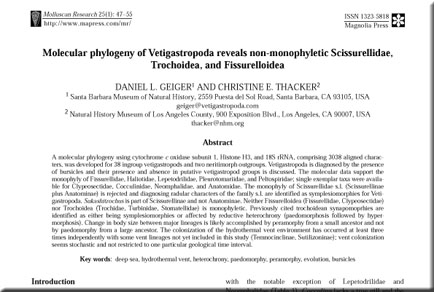Abstract
A molecular phylogeny using cytochrome c oxidase subunit 1, Histone H3, and 18S rRNA, comprising 3038 aligned characters, was developed for 38 ingroup vetigastropods and two neritimorph outgroups. Vetigastropoda is diagnosed by the presence of bursicles and their presence and absence in putative vetigastropod groups is discussed. The molecular data support the monophyly of Fissurellidae, Haliotidae, Lepetodrilidae, Pleurotomariidae, and Peltospiridae; single exemplar taxa were available for Clypeosectidae, Cocculinidae, Neomphalidae, and Anatomidae. The monophyly of Scissurellidae s.l. (Scissurellinae plus Anatominae) is rejected and diagnosing radular characters of the family s.l. are identified as symplesiomorphies for Vetigastropoda. Sukashitrochus is part of Scissurellinae and not Anatominae. Neither Fissurelloidea (Fissurellidae, Clypeosectidae) nor Trochoidea (Trochidae, Turbinidae, Stomatellidae) is monophyletic. Previously cited trochoidean synapomoprhies are identified as either being symplesiomorphies or affected by reductive heterochrony (paedomorphosis followed by hypermorphosis). Change in body size between major lineages is likely accomplished by peramorphy from a small ancestor and not by paedomorphy from a large ancestor. The colonization of the hydrothermal vent environment has occurred at least three times independently with some vent lineages not yet included in this study (Temnocinclinae, Sutilizoninae); vent colonization seems stochastic and not restricted to one particular geological time interval.

